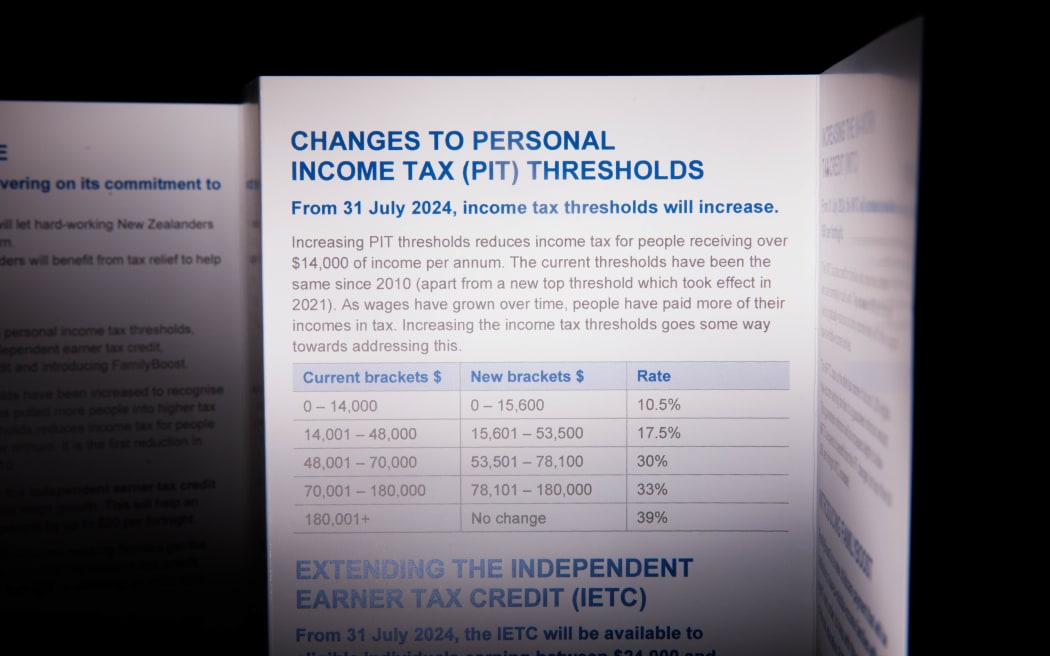Budget 2024: Here Is How To Calculate Your Tax Relief

Tax brackets might have shifted, but the savings are barely scratching the surface of the inflation that has hit households over recent years.
It was confirmed on Thursday the government would go ahead with the tax bracket adjustments National outlined before the election.
It would also change the eligibility for the independent earner tax credit (IETC) so that it applied to people earning up to $70,000 rather than the current $48,000 and increase the in-work Working for Families tax credit by $25 a week.
But the income at which Working for Families credits start to be clawed back would not change, nor will the rate at which that happened.
As signalled, families with children in early childhood education would also receive a subsidy of up to $75 per week if they earn up to $140,000, reducing to $18.75 for households earning $170,0000.
Finance Minister Nicola Willis said it was the first tax relief in 14 years - but commentators say it does little to address the rising costs that households have faced over that time.
Read more on Budget 2024:
- National unveils Budget 2024, keeps tax cut promises
- What the Budget means for you, in charts
- The Budget winners and losers
- Budget 2024 at a glance: What you need to know
Using scenarios that RNZ developed earlier in the week, the government's calculator showed households would be in for tax savings ranging from 0.65 percent of annual income through to more than 5 percent, influenced in part by whether a household paid for early childhood education.
The new bands mean that the 10.5 percent tax rate applies on income to $15,600, while the 17.5 percent tax rate will apply to income between $15,601 and $53,500.
The 30 percent rate will apply between $53,501 and $78,100, the 33 percent rate between $78,101 and $180,000 and the 39 percent rate will still apply to income above $180,000.
But if the rates had been adjusted for the inflation that had happened since they were set in 2011, the 10 percent rate would apply to income up to $18,976, the 17.5 percent rate to income between $18,977 and $65,061, the 30 percent rate to income between $65,062 and $84,881, and the 33 percent rate to income between $94,882 and $213,539. The 39 percent tax rate would not start until income hit $213,540.
Even if the rates had been adjusted for inflation only since 2017, the tax thresholds would have been higher - 10 percent tax on income up to $17,7378, 17.5 percent for income between $17,739 and $60,816, 30 percent for $60,817 to $88,690, 33 percent for $88,691 to $213,539 and 39 percent for income over $213,540.
Independent economist Shamubeel Eaqub said the cuts were probably only taking households back to where they were three or six months ago.
"It's quite wrong to make these band adjustments political. We should not have to pay for inflation. It's been dressed up as a tax cut, but is it really?"

The new tax brackets apply from 31 July. Photo: RNZ / Angus Dreaver
Tax expert Terry Baucher said households at the lower end of the income scale would probably feel the impact.
"At the lower end, where every penny counts, they'll be grateful but it will go straight away on just paying the bills or paying down debt."
He said the change did not come close to covering recent inflation.
The Working for Families threshold for clawback of credits was "way too low", he said: "The poorest people are paying for tax cuts for the landlords. If you're saying a family income of $42,700 is sufficient, in what year?"
Infometrics chief forecaster Gareth Kiernan said the bracket shifts might unwind the impact of 12 to 18 months of price increases.
"You could argue National, when it put the tax brackets in place in 2011, was not getting enough revenue and underinvesting in the economy. But the reality is that the last six years the government has grown substantially and we're faced with a period where there is no additional spending in the next four years to try to bring things back under control."
Robyn Walker, a tax partner at Deloitte, said it was a pleasant surprise to see National stick to its tax plan, given recent commentary around fiscal conditions.
She said it would be nice to see some commitment to regular indexation of tax bands to income in future Budgets, "to prevent the same issue happening again".
Here's what the cuts might look like for a range of households
Single parent, two children (aged 3 and 5), part-time net income of $30,000, no childcare fees
This household would receive a tax cut of $1,412 a year, or $54.31 a fortnight according to the government's calculator.
This household's expenses have increased by 21.54 percent since the first quarter of 2020, and income has not kept pace in dollar terms. The tax cut represents a 4.7 percent increase to household income.
Two adults, one full-time income of $67,000, two children (aged 6 months and 3 years), paying $100 per week for childcare
This household would receive a tax cut of $3,399.50 a year.
The household's expenses are up 21.62 percent from the first quarter of 2020, while the tax cut and childcare credit represent a 5.07 percent boost.
Our data shows wage rises in this bracket have not kept up with inflation in dollar terms.
Two adults, one full-time on $65,000, one part-time on $29,000, two school-aged children, no childcare fees
This household has had a 23.31 percent increase in expenses since the first quarter of 2020.
Their tax cut will be $2,211.50 a year - a 2.35 percent increase to take-home income.
Our data shows this bracket's wage rises have been slightly ahead of their increase in expenses - but this depends a lot on how much debt they are carrying.
Two adults earning $120,000 and $78,000, one non-earning adult and three school-aged children, no childcare fees
This household's expenses have risen 23.69 percent since the start of 2020 and their annual tax cut will be $2,082 or 1.12 percent.
Wage rises have outpaced expenses on average for this income group.
Single adult on $160,000 full time
Expenses are up 23.95 percent since the first quarter of 2020 in this scenario, but their $1,042.50 tax cut is only equal to 0.65 percent of income.
This bracket has had wage rises that have kept ahead of inflation.





